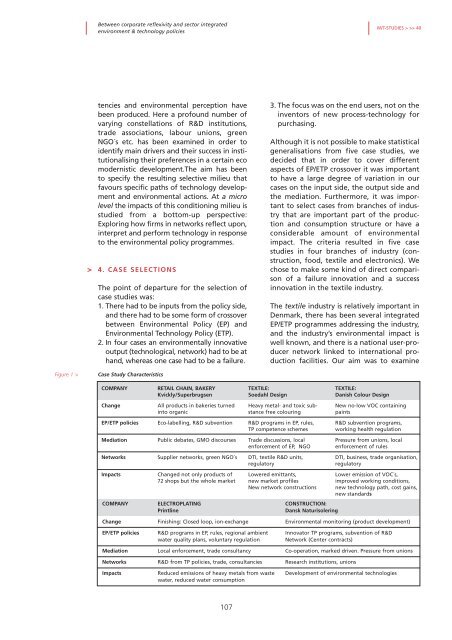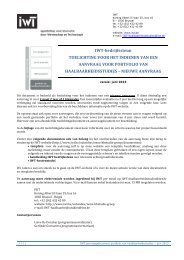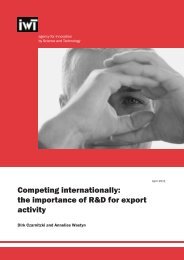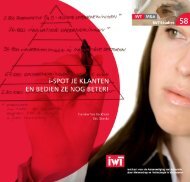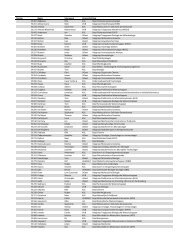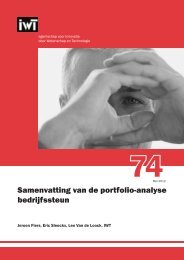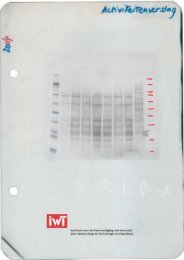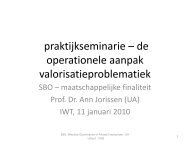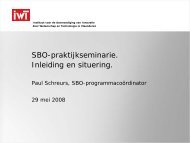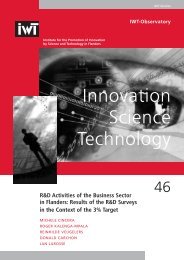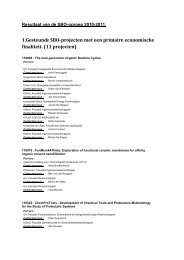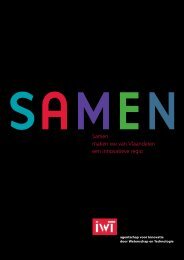40 Innovation Policy and Sustainable Development - IWT
40 Innovation Policy and Sustainable Development - IWT
40 Innovation Policy and Sustainable Development - IWT
You also want an ePaper? Increase the reach of your titles
YUMPU automatically turns print PDFs into web optimized ePapers that Google loves.
Between corporate reflexivity <strong>and</strong> sector integrated<br />
environment & technology policies<br />
<strong>IWT</strong>-STUDIES > >> <strong>40</strong><br />
><br />
tencies <strong>and</strong> environmental perception have<br />
been produced. Here a profound number of<br />
varying constellations of R&D institutions,<br />
trade associations, labour unions, green<br />
NGO´s etc. has been examined in order to<br />
identify main drivers <strong>and</strong> their success in institutionalising<br />
their preferences in a certain eco<br />
modernistic development.The aim has been<br />
to specify the resulting selective milieu that<br />
favours specific paths of technology development<br />
<strong>and</strong> environmental actions. At a micro<br />
level the impacts of this conditioning milieu is<br />
studied from a bottom-up perspective:<br />
Exploring how firms in networks reflect upon,<br />
interpret <strong>and</strong> perform technology in response<br />
to the environmental policy programmes.<br />
4. CASE SELECTIONS<br />
The point of departure for the selection of<br />
case studies was:<br />
1. There had to be inputs from the policy side,<br />
<strong>and</strong> there had to be some form of crossover<br />
between Environmental <strong>Policy</strong> (EP) <strong>and</strong><br />
Environmental Technology <strong>Policy</strong> (ETP).<br />
2. In four cases an environmentally innovative<br />
output (technological, network) had to be at<br />
h<strong>and</strong>, whereas one case had to be a failure.<br />
3. The focus was on the end users, not on the<br />
inventors of new process-technology for<br />
purchasing.<br />
Although it is not possible to make statistical<br />
generalisations from five case studies, we<br />
decided that in order to cover different<br />
aspects of EP/ETP crossover it was important<br />
to have a large degree of variation in our<br />
cases on the input side, the output side <strong>and</strong><br />
the mediation. Furthermore, it was important<br />
to select cases from branches of industry<br />
that are important part of the production<br />
<strong>and</strong> consumption structure or have a<br />
considerable amount of environmental<br />
impact. The criteria resulted in five case<br />
studies in four branches of industry (construction,<br />
food, textile <strong>and</strong> electronics). We<br />
chose to make some kind of direct comparison<br />
of a failure innovation <strong>and</strong> a success<br />
innovation in the textile industry.<br />
The textile industry is relatively important in<br />
Denmark, there has been several integrated<br />
EP/ETP programmes addressing the industry,<br />
<strong>and</strong> the industry’s environmental impact is<br />
well known, <strong>and</strong> there is a national user-producer<br />
network linked to international production<br />
facilities. Our aim was to examine<br />
Figure 1 ><br />
Case Study Characteristics<br />
COMPANY<br />
RETAIL CHAIN, BAKERY<br />
Kvickly/Superbrugsen<br />
All products in bakeries turned<br />
into organic<br />
Eco-labelling, R&D subvention<br />
TEXTILE:<br />
Soedahl Design<br />
Heavy metal- <strong>and</strong> toxic substance<br />
free colouring<br />
R&D programs in EP, rules,<br />
TP competence schemes<br />
Trade discussions, local<br />
enforcement of EP, NGO<br />
DTI, textile R&D units,<br />
regulatory<br />
TEXTILE:<br />
Danish Colour Design<br />
New no-low VOC containing<br />
paints<br />
R&D subvention programs,<br />
working health regulation<br />
Pressure from unions, local<br />
enforcement of rules<br />
DTI, business, trade organisation,<br />
regulatory<br />
Change<br />
EP/ETP policies<br />
Mediation<br />
Public debates, GMO discourses<br />
Networks<br />
Supplier networks, green NGO´s<br />
Impacts<br />
COMPANY<br />
Changed not only products of<br />
72 shops but the whole market<br />
ELECTROPLATING<br />
Printline<br />
Lowered emittants,<br />
new market profiles<br />
New network constructions<br />
CONSTRUCTION:<br />
Dansk Naturisolering<br />
Lower emission of VOC´s,<br />
improved working conditions,<br />
new technology path, cost gains,<br />
new st<strong>and</strong>ards<br />
Change<br />
EP/ETP policies<br />
Mediation<br />
Networks<br />
Impacts<br />
Finishing: Closed loop, ion-exchange<br />
R&D programs in EP, rules, regional ambient<br />
water quality plans, voluntary regulation<br />
Local enforcement, trade consultancy<br />
R&D from TP policies, trade, consultancies<br />
Reduced emissions of heavy metals from waste<br />
water, reduced water consumption<br />
Environmental monitoring (product development)<br />
Innovator TP programs, subvention of R&D<br />
Network (Center contracts)<br />
Co-operation, marked driven. Pressure from unions<br />
Research institutions, unions<br />
<strong>Development</strong> of environmental technologies<br />
107


